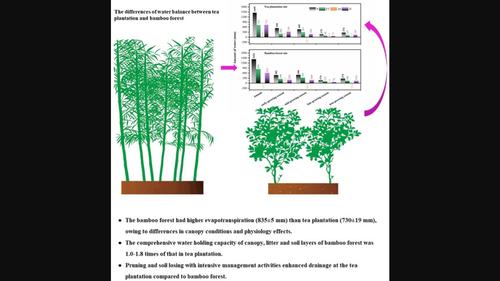当前位置:
X-MOL 学术
›
Hydrol. Process.
›
论文详情
Our official English website, www.x-mol.net, welcomes your feedback! (Note: you will need to create a separate account there.)
The effects of land-use conversion on evapotranspiration and water balance of subtropical forest and managed tea plantation in Taihu Lake Basin, China
Hydrological Processes ( IF 3.2 ) Pub Date : 2022-07-24 , DOI: 10.1002/hyp.14652 Jianwei Geng 1 , Hengpeng Li 1 , Jiaping Pang 1 , Wangshou Zhang 1 , Yunjie Shi 1, 2
Hydrological Processes ( IF 3.2 ) Pub Date : 2022-07-24 , DOI: 10.1002/hyp.14652 Jianwei Geng 1 , Hengpeng Li 1 , Jiaping Pang 1 , Wangshou Zhang 1 , Yunjie Shi 1, 2
Affiliation

|
Widespread clearing of natural forests for tea plantations have profoundly altered the local water balance and energy budget. However, studies of comprehensive effects of land-use conversion on energy and hydrological cycling are still rare. In this study, we used 5 years (2014–2018) of eddy covariance (EC) data, modelled estimates, and hydrological monitoring of different functional layers (canopy, litter and soil layers) to summarize the seasonal and inter-annual variations and differences of evapotranspiration and water balance components in tea plantations (Camellia sinensis) and natural bamboo forests (Phyllostachysedulis). Results suggested the bamboo forest had higher actual evapotranspiration (ETa) (835 ± 5 mm) than the tea plantation (730 ± 19 mm), owing to differences in canopy conditions and plant physiology. Evident differences in ETa components were found between the tea plantation site and the bamboo forest site. The proportion of transpiration (Etr) was higher at the bamboo site (0.71–0.76) than the tea plantation site (0.60–0.65). Additionally, the soil evaporation ratio (0.10–0.13) was lower at the bamboo forest site than the tea plantation site (0.21–0.24) due to vegetation structure differences altering the radiation energy partitioning between the two sites. Moreover, the tea plantations were more susceptible to drought stress with low water storage in soil and simple rhizome-root system. The comprehensive water holding capacity of canopy, litter, and soil layers of bamboo forest was 1.0–1.8 times of that in tea plantation. Compared with bamboo forest, pruning and losing of soil with intensive management activities enhanced drainage at the tea plantation site. This study provides insights into land-use conversion of subtropical forest and managed tea plantation that have important implications on regional energy and water budgets.
中文翻译:

土地利用转换对太湖流域亚热带森林和茶园蒸散和水分平衡的影响
为茶园而大面积砍伐天然林已深刻改变了当地的水平衡和能源预算。然而,关于土地利用转换对能源和水文循环的综合影响的研究仍然很少。在这项研究中,我们使用了 5 年(2014-2018 年)的涡度协方差 (EC) 数据、建模估计和不同功能层(冠层、凋落物和土壤层)的水文监测来总结季节和年际变化和差异茶园(Camellia sinensis)和天然竹林(Phyllostachysedulis)蒸发蒸腾和水分平衡成分的研究。结果表明竹林的实际蒸散量(ET a)(835 ± 5 毫米)比茶园(730 ± 19 毫米),由于冠层条件和植物生理的差异。在茶园和竹林地之间发现了明显的ET a成分差异。蒸腾比例(E tr)在竹子场地(0.71-0.76)高于茶园场地(0.60-0.65)。此外,由于植被结构差异改变了两个地点之间的辐射能量分配,竹林地点的土壤蒸发率(0.10-0.13)低于茶园地点(0.21-0.24)。此外,茶园更容易受到干旱胁迫的影响,土壤蓄水量低,根茎系统简单。竹林冠层、凋落物层和土层的综合持水量是茶园的1.0~1.8倍。与竹林相比,集约化管理活动的土壤修剪和流失增强了茶园的排水。
更新日期:2022-07-24
中文翻译:

土地利用转换对太湖流域亚热带森林和茶园蒸散和水分平衡的影响
为茶园而大面积砍伐天然林已深刻改变了当地的水平衡和能源预算。然而,关于土地利用转换对能源和水文循环的综合影响的研究仍然很少。在这项研究中,我们使用了 5 年(2014-2018 年)的涡度协方差 (EC) 数据、建模估计和不同功能层(冠层、凋落物和土壤层)的水文监测来总结季节和年际变化和差异茶园(Camellia sinensis)和天然竹林(Phyllostachysedulis)蒸发蒸腾和水分平衡成分的研究。结果表明竹林的实际蒸散量(ET a)(835 ± 5 毫米)比茶园(730 ± 19 毫米),由于冠层条件和植物生理的差异。在茶园和竹林地之间发现了明显的ET a成分差异。蒸腾比例(E tr)在竹子场地(0.71-0.76)高于茶园场地(0.60-0.65)。此外,由于植被结构差异改变了两个地点之间的辐射能量分配,竹林地点的土壤蒸发率(0.10-0.13)低于茶园地点(0.21-0.24)。此外,茶园更容易受到干旱胁迫的影响,土壤蓄水量低,根茎系统简单。竹林冠层、凋落物层和土层的综合持水量是茶园的1.0~1.8倍。与竹林相比,集约化管理活动的土壤修剪和流失增强了茶园的排水。



























 京公网安备 11010802027423号
京公网安备 11010802027423号